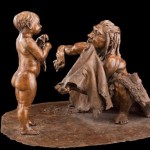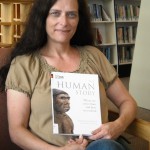“Exploring Human Origins: What Does It Mean To Be Human,” a 4-week traveling exhibition, will be coming to the Ephrata Public Library July 29-August 25.
The American Library Association Public Programs Office, in collaboration with the Smithsonian’s National Museum of Natural History Human Origins Program, has made the Smithsonian’s Hall of Human Origins traveling exhibition available to the public. Ephrata Public Library is one of only 19 libraries in the nation to have been awarded this exhibition.

Anthropologist/Artist John Gurche’s bronze sculpture of a Homo neanderthalensis mother and child in the David H. Koch Hall of Human Origins.
The components of the display include forty, full color information panels, two interactive touch screen kiosks, a display of skulls, a relief mat of early-man footprints, a statue of a Neanderthal woman and child, and two DVDs.
For the first week of the showing, associated programs will be facilitated by the Hall of Human Origins curator, Dr. Rick Potts, and his associate and leading paleontologist, Dr. Briana Pobiner. The Broader Social Impact Committee’s Dr. Connie Bertka and Dr. Jim Miller will also be sharing in these programs. Furthermore, the Ephrata Public Library is offering programs during the four weeks that complement the theme of the exhibition: What Does It Mean To Be Human?
The purpose of this exhibition is to create an opportunity for audiences across a wide spectrum of beliefs to engage in the complex field of human evolution research in ways that are understandable, fulfilling, captivating and relevant. Reflection on the question, “What Does It Mean To Be Human?” will be discussed. Exhibition sponsors endeavor to create a respectful and welcoming atmosphere for public audiences to explore how, when and where human qualities emerged. The goal is to inspire audiences to initiate and engage in open, constructive and civil conversation about the natural world and evolution through the lens of human origins.
There are several reasons why Ephrata Public Library sought out this grant, and is so thrilled to have received it. First, this exhibition fits the Library’s mission: “…to offer free access to information reflecting differing viewpoints in order to support an open and democratic society.” It feels that this exhibition is an appropriate means to further its purpose and vision for the community in which it serves. Secondly, the exhibition provides the opportunity to develop listening skills and to find common ground.
 “This is a teachable moment and much needed in our community,” said Penny Talbert, Director of the Ephrata Public Library. “This is an extremely difficult subject to discuss. There is a lot of emotion in it. By learning to focus on what we think it means to be human and learning to find common ground in this, we feel it will transfer to other difficult subjects that greatly impact our community.”
“This is a teachable moment and much needed in our community,” said Penny Talbert, Director of the Ephrata Public Library. “This is an extremely difficult subject to discuss. There is a lot of emotion in it. By learning to focus on what we think it means to be human and learning to find common ground in this, we feel it will transfer to other difficult subjects that greatly impact our community.”
A third reason is the opportunity the exhibition offers to provide STEM education to our community’s youth, particularly those who are underserved and/or underrepresented in the fields of Science, Technology, Engineering and Math. “This may be the only Smithsonian some of our kids will ever see,” said Talbert.
The focus of this exhibition is to reflect and respond to the question, “What does it mean to be human?” One of the exhibit’s panels is the “response panel.” Here, individuals will write a word or a brief phrase about what they think it means to be human on a sticky note, than place it directly onto the panel. Examples of responses may be “Love” or “Creativity” or “Our desire to worship.” “There are no wrong answers,” said Ashley, “The sticky notes are then collected after a time and sent to the National Museum of Natural History to be part of the Hall of Human Origins collection. Imagine! Hundreds of thousands of sticky notes collected from across the country over a two year period reflecting on what we think it means to be human.”
The audience will also have the opportunity to share their thoughts during some of the programs. “A Community Conversation,” a program facilitated by the Broader Social Impact Committee’s Drs. Bertka and Miller, will discuss how the scientific discoveries relate to people’s personal understanding of the world and their place in it.
The Library will also offer a writing contest for teens and adults. Participants are encouraged to visit the exhibition, than complete an essay answering the question, “What does it mean to be human?” The two winners from both age categories will receive a prize.
The Exploring Human Origins Facebook page is another avenue for people to post their thoughts about what it means to be human.
The Library is not trying to change any one person’s personal conviction or beliefs. It is to provide access to information, and the audience is free to interpret the information, and even to test the information, at a very personal level. To find more information about this exhibition visit here. This Library guide shows videos of the exhibition and the scientists. It lists books and DVDs purchased as part of the Library’s permanent collection. For those visitors outside of the community, a special links page has been added for hotel and restaurant information. Viewers can also learn about and purchase tickets for the upcoming “Sharing the Bread” Farm-to-Table Community Benefit Dinner.
Exploring Human Origins: What Does It Mean to Be Human? was organized by the Smithsonian’s National Museum of Natural History in collaboration with the American Library Association Public Programs Office. This project was made possible through the support of a grant from the John Templeton Foundation and support from the Peter Buck Human Origins Fund.

